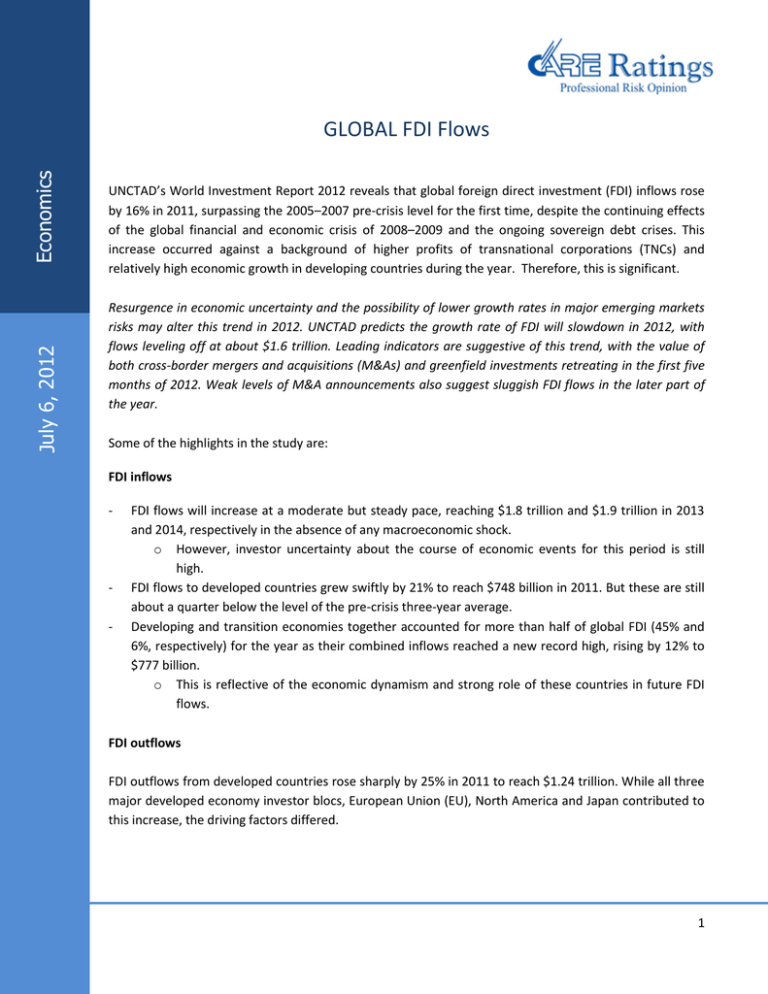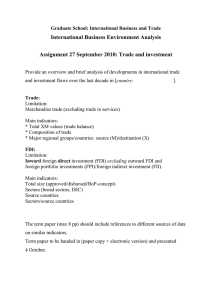GLOBAL FDI Flows s ic
advertisement

Economics GLOBAL FDI Flows UNCTAD’s World Investment Report 2012 reveals that global foreign direct investment (FDI) inflows rose by 16% in 2011, surpassing the 2005–2007 pre-crisis level for the first time, despite the continuing effects of the global financial and economic crisis of 2008–2009 and the ongoing sovereign debt crises. This increase occurred against a background of higher profits of transnational corporations (TNCs) and relatively high economic growth in developing countries during the year. Therefore, this is significant. July 6, 2012 Resurgence in economic uncertainty and the possibility of lower growth rates in major emerging markets risks may alter this trend in 2012. UNCTAD predicts the growth rate of FDI will slowdown in 2012, with flows leveling off at about $1.6 trillion. Leading indicators are suggestive of this trend, with the value of both cross-border mergers and acquisitions (M&As) and greenfield investments retreating in the first five months of 2012. Weak levels of M&A announcements also suggest sluggish FDI flows in the later part of the year. Some of the highlights in the study are: FDI inflows - - FDI flows will increase at a moderate but steady pace, reaching $1.8 trillion and $1.9 trillion in 2013 and 2014, respectively in the absence of any macroeconomic shock. o However, investor uncertainty about the course of economic events for this period is still high. FDI flows to developed countries grew swiftly by 21% to reach $748 billion in 2011. But these are still about a quarter below the level of the pre-crisis three-year average. Developing and transition economies together accounted for more than half of global FDI (45% and 6%, respectively) for the year as their combined inflows reached a new record high, rising by 12% to $777 billion. o This is reflective of the economic dynamism and strong role of these countries in future FDI flows. FDI outflows - FDI outflows from developed countries rose sharply by 25% in 2011 to reach $1.24 trillion. While all three major developed economy investor blocs, European Union (EU), North America and Japan contributed to this increase, the driving factors differed. - 1 Economics o o o - FDI from the United States was driven by a record level of reinvested earnings (82% of total FDI outflows driven mostly by TNCs (transnational corporations) building on their foreign cash holdings). The rise of FDI outflows from the EU was driven by cross-border M&As. Japan witnessed an increase due to an appreciating yen which improved the purchasing power of Japanese TNCs, resulting in a doubling of their FDI outflows. Outward FDI from developing economies declined by 4% to $384 billion in 2011, although their share in global outflows remained high at 23%. o Flows from Latin America and the Caribbean fell by 17%, largely owing to the repatriation of capital to the region motivated in part by financial considerations such as exchange rates and interest rate differentials. o Flows from East and South East Asia were largely stagnant while outward FDI from West Asia increased significantly to $25 billion. FDI composition - - Cross-border M&As rose by 53% in 2011 to $526 billion, spurred by a rise in the number of megadeals (those with a value over $3 billion) to 62 from 44 in 2010. o This reflects both the growing value of assets on stock markets and the increased financial capacity of buyers to carry out such operations. Greenfield investment projects, which had declined in value terms for two years held steady in 2011 at $904 billion. o Developing and transition economies continued to host more than two thirds of the total value of greenfield investments in 2011. Although the growth in global FDI flows in 2011 was driven in large part by cross-border M&As, the total project value of greenfield investments remains significantly higher than that of cross-border M&As, as has been the case since the financial crisis. FDI Policies Against a backdrop of continued economic uncertainty, turmoil in financial markets and slow growth, countries worldwide continued to liberalize and promote foreign investment as a means to support economic growth and development. At the same time, regulatory activities with regard to FDI continued. - Investment policy measures undertaken in 2011 were generally favorable to foreign investors. - Compared with 2010, the percentage of more restrictive policy measures showed a significant decrease from approximately 32% to 22%. o However, it is premature to interpret this decrease as an indication of a reversal of the trend towards a more stringent policy environment for investment that has been observed in previous years – also because the 2011 restrictive measures add to the stock accumulated in previous years. Global FDI Flows 2 Economics - The overall policy trend towards investment liberalization and promotion appears more to be targeted at specific industries, especially services industries (e.g. electricity, gas and water supply; transport and communication). Restrictive policies More State regulation became manifest primarily in two policy areas - Adjustment of entry policies with regard to inward FDI by introducing new entry barriers by reinforcing screening procedures (in e.g. agriculture, pharmaceuticals). Regulatory policies in extractive industries, including nationalization, expropriation or divestment requirements as well as increases in corporate taxation rates, royalties and contract renegotiations. Both policy types were partly driven by industrial policy considerations. Extractive industries proved the main exception in as much as most policy measures related to this industry were less favorable. Agribusiness and financial services were the other two industries with a relatively high share of less favorable measures. Where did it go? - - FDI flows rose in all three sectors of production (primary, manufacturing and services), and the rise was widespread across all major economic activities. FDI in the services sector rebounded in 2011 to reach some $570 billion, after falling sharply in the previous two years. Investment in the primary sector also reversed the negative trend of the previous two years, reaching $200 billion. o FDI in the primary sector rose gradually, characterized by an increase in investment in mining, quarrying and petroleum. It now accounts for 14% of total FDI projects. The share of both sectors rose slightly at the expense of the manufacturing sector. The value of FDI projects in manufacturing rose by 7% in 2011. o The largest increases were observed in the food and chemicals industries, while FDI projects in coke, petroleum and nuclear fuel saw the biggest percentage decrease. The food, beverages and tobacco industry was among those least affected by the crisis because it produces mainly basic consumption goods. o The chemicals industry saw 65% rise in FDI, mainly as a result of large investments in pharmaceuticals. Among the driving forces behind its growth is the dynamism of its final markets, especially in emerging economies, as well as the need to set up production capabilities for new health products and an ongoing restructuring trend throughout the industry. o The automotive industry on the other hand was strongly affected by the economic uncertainty in 2011. Global FDI Flows 3 Economics FDI Attraction Index The ranking of economies in UNCTAD’s FDI Attraction Index measures countries’ success in attracting FDI over a rolling three-year period. The top performers – Hong Kong, Belgium, Singapore and Luxembourg have high absolute inflows because of their attractive investment climates and the important “hinterlands” for which they act as gateways, and with outsized inflows relative to the size of their economies. A number of resource-rich countries also feature in the higher ranks of the index, as resource-seeking FDI essentially ignores host-country size (as well as other determinants of FDI). In the top 10, these are Chile, Kazakhstan, Mongolia, Turkmenistan and Congo while Saudi Arabia (12th), Chad (14th) and Ghana (16th) follow. Quite clearly a number of developing and transition economies have managed to attract more FDI than expected, including Albania, Cambodia, Madagascar and Mongolia. FDI flows across the globe ($ bn) Region 2006 2011 2006 2011 Inflows Outflows World 1,463 1,524 1,415 1,694 Developed countries 981 747 1,152 1,237 Europe 640 425 794 651 France 72 40 111 90 Germany 55 40 118 54 UK 156 54 102 89 USA 237 226 224 396 Japan -6.5 -1.7 74 114 Developing countries 427 685 239 384 China 73 124 21 65 Hong Kong 45 83 45 82 Singapore 37 64 18 25 India 20 32 14 15 Brazil 19 67 28 -1.0 Russia 29 53 23 67 Source: UNCTAD, World Investment Report, 2012 The table above gives information on FDI flows in 2006 and 2011. The numbers cannot really be compared on a point to point basis as flows have been affected during the crisis years in 2008 and 2009. FDI inflows had increased to a high of $ 1,975 bn in 2007, and then came down to $ 1,790 bn in 2008 and further to $ 1,197 bn in 2009. However it recovered to $ 1,309 bn in 2010 and further to $ 1,524 bn in 2011. Evidently the present sovereign debt crisis has not had an impact on overall flows with even the Europe region witnessing an increase in 2011 over 2010. Global FDI Flows 4 Economics FDI and India FDI into India had peaked in 2008 at $ 43 bn and then came down to $ 24 bn by 2010 after which there has been a recovery. Outward FDI too had peaked in 2007 and 2008 when Indian companies were on an acquisition drive. However, it has settled down to levels of $ 14-15 bn by 2010-11. Compared with the BRICs nations, India gets in relatively a lower quantity of FDI. There is evidently scope for increasing this amount through appropriate policy measures. Areas like banking, insurance, pensions, retail, power, mining, etc. could be of interest to FDI provided the policy environment is favourable. Based on data provided by the Ministry of Commerce, the main countries investing into India are Mauritius (38%), followed by Singapore (10%), UK (9%), Japan (7%) and USA (6%). The top 10 recipient industries are services (19%), telecom (7%), construction (7%), computer (7%), housing (6%), chemicals (6%), Drugs and pharma (6%), power (4%), auto (4%) and metallurgical (4%). The concern with India’s balance of payments should be kept in mind when looking at FDI policy. Presently the capital flows are supporting the rising current account deficit through foreign investment, ECBs and NRI deposits. FDI in particular has a dual advantage. Firstly, it is in the nature of equity which means that it does not create debt which has to be serviced. Given that our external debt is now $ 346 bn and increasing, it would be advisable to focus more in equity flows. Second, FDI unlike FII goes directly for capital formation, which is required for the country given the demand for funds for investment. Cumulatively India has garnered $ 202 bn of FDI as against China’s $ 1800 bn. Using these funds in the natural resources sector would be the logical route to begin with to draw these benefits. In the light of the statements made by the Prime Minister recently on FDI, it could be expected that there could be some announcements made this year relating to FDI in specific sectors which will help to maintain the pace of growth. Global FDI Flows 5 Economics Contact: Madan Sabnavis Chief Economist madan.sabnavis@careratings.com 91-022-67543489 Anuja Jaripatke Associate Economist anuja.jaripatke@careratings.com 91-022-67543552 Disclaimer This report is prepared by the Economics Division of Credit Analysis & Research Limited [CARE]. CARE has taken utmost care to ensure accuracy and objectivity while developing this report based on information available in public domain. However, neither the accuracy nor completeness of information contained in this report is guaranteed. CARE is not responsible for any errors or omissions in analysis/inferences/views or for results obtained from the use of information contained in this report and especially states that CARE (including all divisions) has no financial liability whatsoever to the user of this report. Credit Analysis and Research Limited proposes, subject to receipt of requisite approvals, market conditions and other considerations, to make an initial public offer of its equity shares and has filed a draft red herring prospectus (“DRHP”) with the Securities and Exchange Board of India (“SEBI”). The DRHP is available on the website of SEBI at www.sebi.gov.in as well as on the websites of the Book Running Lead Managers at www.investmentbank.kotak.com, www.dspml.com, www.edelcap.com, www.icicisecurities.com, www.idbicapital.com, and www.sbicaps.com. Investors should note that investment in equity shares involves a high degree of risk and for details relating to the same, see the section titled “Risk Factors” of the DRHP. This press release is not for publication or distribution to persons in the United States, and is not an offer for sale within the United States of any equity shares or any other security of Credit Analysis & Research Ltd. Securities of Credit Analysis & Research Ltd., including its equity shares, may not be offered or sold in the United States absent registration under U.S. securities laws or unless exempt from registration under such laws. Global FDI Flows 6







